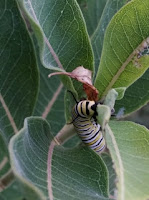 |
| A Monarch larva (Danaus plexippus) on Common Milkweed (Asclepias syriaca) |
 |
| A Monarch caterpillar on Common Milkweed. Creek Field, 2016 |
With Swamp Milkweed, it's a different story!
 |
| Monarch caterpillars munch on Swamp Milkweed leaves. |
Every year in August and September, when Asclepias incarnata blooms in our wetland areas, it is covered with Monarch caterpillars--and many other creatures, as well.
Here a Monarch caterpillar on Swamp Milkweed forms a backward "J," indicating that it's getting ready to pupate.
The tiny round yellow-orange creatures are aphids!
They can strip the milkweed bare.
But nature has its checks and balances.
Here is a Syrphid fly larva on the Swamp Milkweed stem, moving in on that aphid on the right. The larva's purpose in life? To eat aphids!
 |
| Toxomerus politus, getting minerals from the surface of my skin, August 2016. Though a fly, this species is a bee-mimic. Resembling creatures that can sting is a good protection! |
Pollinators other than Monarchs love the late-blooming Swamp Milkweed as well.
 Here is a Dun Skipper (Euphyes vestris) nectaring on Swamp Milkweed. She is one of the subtly patterned but absolutely adorable Grass Skippers. Those eyes! That cape! This one lays eggs on sedges, the larval food plant.
Here is a Dun Skipper (Euphyes vestris) nectaring on Swamp Milkweed. She is one of the subtly patterned but absolutely adorable Grass Skippers. Those eyes! That cape! This one lays eggs on sedges, the larval food plant. Though the Monarchs munched heartily, as shown in the video above, and aphids & milkweed bugs took their toll, the Swamp Milkweed still had enough energy to produce abundant seeds.
 |
| The seeds of Asclepias incarnata dispersing, Sept. 2016 |
I had been worried because the constant spring rains had turned the wetland into a deep pool. Swamp Milkweed is a perennial that likes wet feet, but could it survive being underwater for a month? I was relieved when right on schedule it leafed out and bloomed.
The seeds promise even more Swamp Milkweed next year!



No comments:
Post a Comment